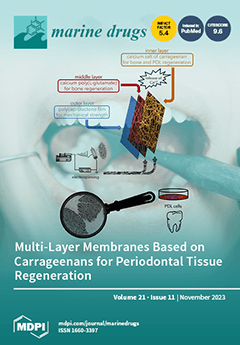Two new compounds, named rhizoaspergillin A (
1) and rhizoaspergillinol A (
2), were isolated from the mangrove endophytic fungus
Aspergillus sp. A1E3, associated with the fruit of
Rhizophora mucronata, together with averufanin (
3). The planar structures and
[...] Read more.
Two new compounds, named rhizoaspergillin A (
1) and rhizoaspergillinol A (
2), were isolated from the mangrove endophytic fungus
Aspergillus sp. A1E3, associated with the fruit of
Rhizophora mucronata, together with averufanin (
3). The planar structures and absolute configurations of rhizoaspergillinol A (
2) and averufanin (
3) were established by extensive NMR investigations and quantum-chemical electronic circular dichroism (ECD) calculations. Most notably, the constitution and absolute configuration of rhizoaspergillin A (
1) were unambiguously determined by single-crystal X-ray diffraction analysis of its
tri-pivaloyl derivative
4, conducted with Cu Kα radiation, whereas those of averufanin (
3) were first clarified by quantum-chemical ECD calculations. Rhizoaspergillin A is the first orsellinic acid–ribose–pyridazinone-
N-oxide hybrid containing a unique β-oxo-2,3-dihydropyridazine 1-oxide moiety, whereas rhizoaspergillinol A (
2) and averufanin (
3) are sterigmatocystin and anthraquinone derivatives, respectively. From the perspective of biosynthesis, rhizoaspergillin A (
1) could be originated from the combined assembly of three building blocks, viz., orsellinic acid, β-D-ribofuranose, and
L-glutamine. It is an unprecedented alkaloid-
N-oxide involving biosynthetic pathways of polyketides, pentose, and amino acids. In addition, rhizoaspergillinol A (
2) exhibited potent antiproliferative activity against four cancer cell lines. It could dose-dependently induce G2/M phase arrest in HepG2 cells.
Full article






